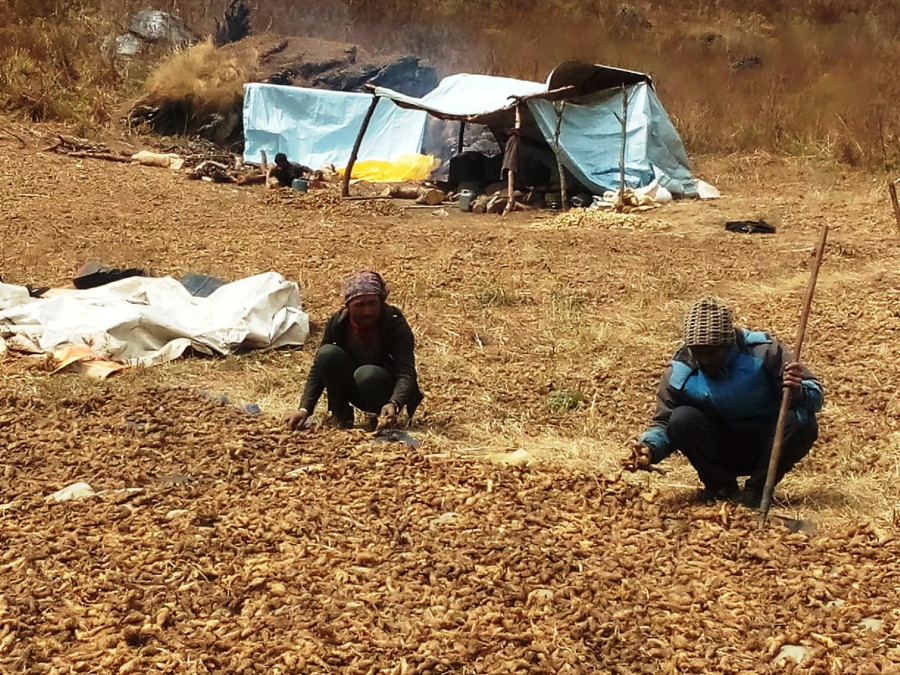
 i_need_contribute
i_need_contribute

Basant Pratap Singh/TKP
China has opened the door for the import of over a dozen medicinal herbs from Nepal for producing medicine.
When Prime Minister Pushpa Kamal Dahal visited China in late September, the two countries signed the Protocol of Phytosanitary Requirements for the export of plant-derived medicinal materials for Chinese medicine from Nepal to China.
The Ministry of Agriculture and Livestock Development and the General Administration of Customs of China had signed the protocol.
“The protocol was signed to enable the export of 15 types of medicinal herbs to China,” said Sabnam Shivakoti Aryal, spokesperson for the Ministry of Agriculture and Livestock Development. “When we get the signed document, we will try to register the products in China in coordination with the Chinese authorities.”
According to Aryal, the Nepali side had proposed registering Nepali export products within a month of the protocol signing. Nepal has long been complaining about non-tariff barriers imposed by China and how that makes the entry of Nepali products into the vast Chinese market difficult.
For agriculture and medicinal herbs, quarantine-related restrictions have emerged as major hurdles. The northern neighbour has sought to address them through the protocol of Phytosanitary Requirements for export.
According to the Plant Quarantine and Pesticide Management Centre, the 15 product include Phyllanthi fructus; Paridis rhizoma; Aquilariae lignum resinatum; Semen herpetospermi; Murrayae folium et cacumen; Cassiae semen; Santali albi lignum; Herba swertiae chiratitae; Polygonati rhizoma; Amomi fructus rotundus; Ganoderma; Rubiae radix et rhizoma; Piperis longi fructus; Ferulae resina; and Justiciae adhatodae foliun.
“It is significant development after our recent export of haylage to China,” said Mahesh Chandra Acharya, information officer at the Plant Quarentine and Pesticide Management Centre. In July, eight metric tonnes of haylage, a nutritious animal feed, was exported to China in the first phase.
To prepare haylage, green maize and other nutritious grasses are first cut into small pieces, then wrapped with air proofing and stored for at least 130 days.
“First we need to penetrate the Chinese market and gradually increase the export of medicinal herbs,” Acharya said. “It is also vital that the Chinese side does not create unnecessary bureaucratic hurdles for the import of our products.”
Nepali officials say that Nepal has a lot of medicinal herbs and agricultural goods which could be exported to China. Protocol signed for the export of 15 medicinal herbs should be taken as the first step towards enabling export of similar goods, they said. “The best thing would be to bring all the medicinal herbs under a single umbrella, opening the door for export of all types of medicinal herbs to the Chinese market,” said Acharya.
Officials also said that signing of protocols alone would not be enough. “The protocol laid down provisions concerning phytosanitary requirements for the export of 15 types of medicinal herbs, but there could be other requirements as well,” said Shivakoti.
According to her, before the protocol was signed, the Chinese side had sent a questionnaire seeking information about production and harvesting status and locations and regions where these medicinal herbs are produced in Nepal. “We had sent the details after holding discussions with relevant government offices and other stakeholders,” she said.
Besides signing the protocol, China had expressed its readiness to speed up the approval process for the export of cooked buffalo meat products from Nepal to China, according to the joint statement issued during the visit of Prime Minister Dahal.
“They [Chinese side] responded positively to our request for the export of buffalo meat,” said Shivakoti. “But it may take time because many issues including buffalo-borne disease control and other requirements will have to be fulfilled before its export.”
Names of the medicinal herbs
1 Phyllanthi fructusThe dry ripe fruit of Phyllanthus emblica
2Paridis rhizomaThe dry rhizome of Paris polyphylla var. yunnanensis or Paris polyphylla var.chinensis
3Aquilariae lignum resinatumThe dry wood containing resin of Aquilaria sinensis
4Semen herpetospermiThe dry ripe seed of Herpetospermum pedunculosum
5Murrayae folium et cacumenThe dry leaves of Murraya exotica or Murraya paniculata
6Cassiae semenThe dry ripe seed of Cassia obtusifolia or Cassia tora
7Santali albi lignum.The dry heartwood of tree trunk of Santalum album
8Herba swertiae chiratitaeThe dry whole plant of Swertia speciosa
9Polygonati rhizomaThe dry rhizome of Polygonatum kingianum, Polygonatum sibiricum or Polygonatum cyrtonema
10Amomi fructus rotundusThe dry ripe fruit of Amomum kravanh or Amomum compactum
11Ganoderma The dry fruiting body of Ganoderma lucidum or Ganoderma sinense
12Rubiae radix et rhizomaThe dry root or root stock of Rubia cordifolia
13Piperis longi fructusThe dry nearly ripe or ripe ears of Piper longum
14Ferulae resinaThe resin of Ferula sinkiangensis orFerula fukanensis
15Justiciae adhatodae foliunThe dry leaves of Justicia adhatoda